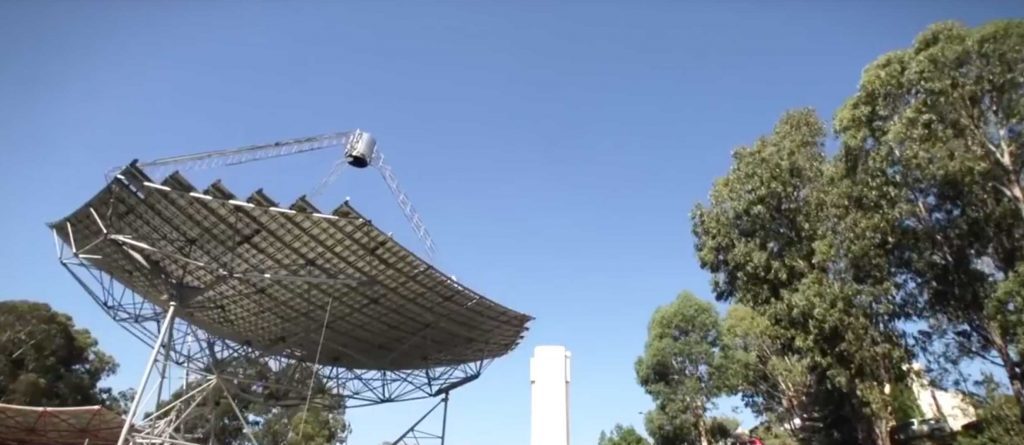So hot right now: ANU at the cutting edge of solar thermal
With its notoriously chilly winters, Canberra isn’t the sort of place you associate with high temperatures. But tucked away on the city’s Australian National University (ANU) campus, a group of researchers are turning up the heat on solar thermal technology.

What is concentrating solar power?
Concentrating solar thermal (CST) power uses mirrors to focus a lot of sunlight onto a solar receiver lined with tubes of fluid. The concentrated solar energy heats up the fluid, which is used to generate electricity via a steam turbine or similar process.
CST is great because it comes with built-in storage – the hot fluid can be stored in tanks, letting us generate power 24/7 and improve the reliability of the energy supply as more renewables are added.
CST doesn’t generate power as cheaply as solar PV panels. But judging by the innovative receiver designs coming out of the ANU’s Solar Thermal Group, that is going to change very soon.
Liquid metal receivers
Most modern CST systems use molten salt as the all-important heat transfer fluid. Salts have a high thermal capacity, meaning they absorb a lot of solar energy and can store heat for a long time with quite a small amount of material.
The hotter the salt gets, the more efficiently electricity can be generated. However, the nitrate salts used in current CST plants decompose once they hit 600ºC, placing a hard limit on their maximum efficiency.
The ANU’s Solar Thermal Group (as part of the ARENA-supported ASTRI> consortium) have found a way around this limit: replace the molten salts in the receiver with pure liquid sodium.
‘Sodium is a liquid between about 100ºC and 900ºC,’ explains Senior Research Fellow Joe Coventry. ‘One of the really nice things about it is that it’s a metal, so it has very high conductivity. That means it can absorb energy really well, which allows us to make the actual solar receiver smaller.’
Joe estimates that using sodium as a heat transfer fluid in CST plants could reduce the receiver size by around 30%, improving its efficiency and potentially shrinking its cost.
Sodium’s relatively low 100ºC freezing point means it’s a lot easier to pump around than salts, making it the perfect fluid for modular CST plants that link multiple small solar towers together.
The Solar Thermal Group is looking at ways to boost the performance of sodium receivers by pushing up temperatures, overcoming some limitations of the materials and improving the technology’s integration with energy storage.
The group’s industry partner Vast Solar has already demonstrated a sodium receiver design at their Jemalong Solar Station Pilot, adding to Australia’s reputation as an international leader in this field.
Bladed receivers
Thanks to a $1.36 million ARENA grant, the Solar Thermal Group is also looking into the potential of ‘bladed’ receivers for high-temperature CST.
Instead of flat banks of tubes, a bladed receiver uses tube banks set on an angle like window louvres. The angled blades mean solar radiation is distributed over a larger area, while the gaps between the blades capture light, trap hot air and cut heat losses. Jets of air can also be used to control heat loss from the outside of the receiver.
‘The aim of this project is to combine the bladed concept and active airflow features to achieve up to a 50% reduction in losses from the receivers,’ explains Senior Lecturer John Pye. ‘That would be enough to bring the cost of electricity from these things down by a significant amount.’
The experimental modules have gone through multiple tests in water and wind tunnels to simulate the effects of airflow on heat. The team are using the data from these tests to build computational models that can simulate a large-scale receiver.
These models are helping the researchers calculate the most effective shape and size for each blade. The prototype modules will be put through ‘on-sun’ testing at the CSIRO solar towers in Newcastle next year.
Dishing it out
Since the mid-1970s, the Solar Thermal Group has been at the international forefront of dish-based solar thermal research.
This type of CST generator uses a curved, reflective surface with a receiver mounted on the dish itself (a bit like a mirrored satellite dish). Because it always points directly at the sun, a dish can capture a lot of solar energy from a smaller area of mirrors.
But getting maximum efficiency out of a solar dish means designing a receiver that works at high temperatures while minimising heat loss.
Helped along by $1.49 million of ARENA funding, the Solar Thermal Group has performed extensive optical, thermal and hydrodynamic modelling to design the perfect receiver for the ANU’s dish.
The result is a curved coil of tubes that looks like a stretched-out bowler hat. This shape has been carefully tuned to capture maximum sunlight and optimise heat transfer while making sure no part of the surface gets too hot. The team also modelled potential stresses on the tubes to ensure the new receiver is long lasting as well as efficient.
The test results speak for themselves: the optically tuned receiver achieved a thermal efficiency of more than 97% – a world record for the conversion of concentrated solar energy into heat and steam.
The system is also ripe for commercialisation. ‘Our dish is made with mirror panels created using a mass producible technique,’ John says. ‘The frame is made from very low-cost materials and is designed to be assembled on site.
‘We’re excited to be developing this technology further through our commercial relationship with Sunrise CSP. The next step is a new prototype receiver, which will be built in Brazil in 2018.
‘We believe that this dish technology, when put together with an efficient receiver, offers a completely alternative path for the technology development of CST.’
This article was originally written by Simon Mitchell, Writer.
LIKE THIS STORY? SIGN UP TO OUR NEWSLETTER

ARENA